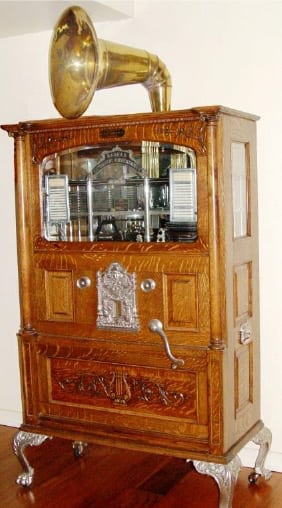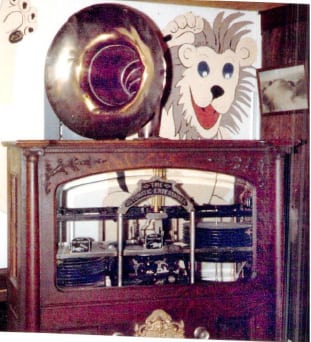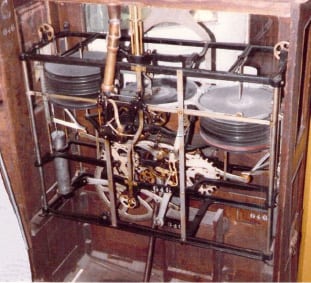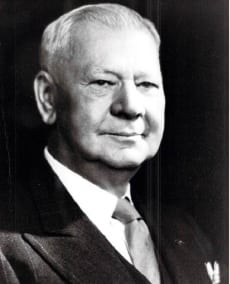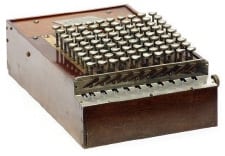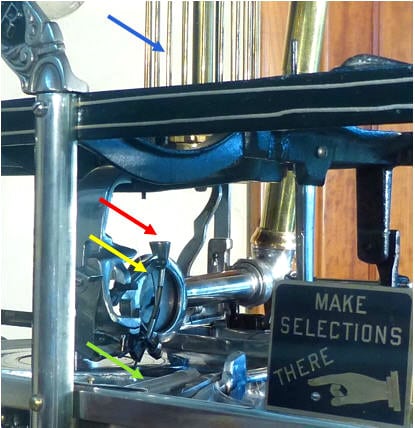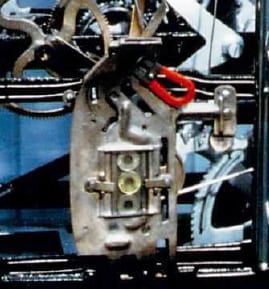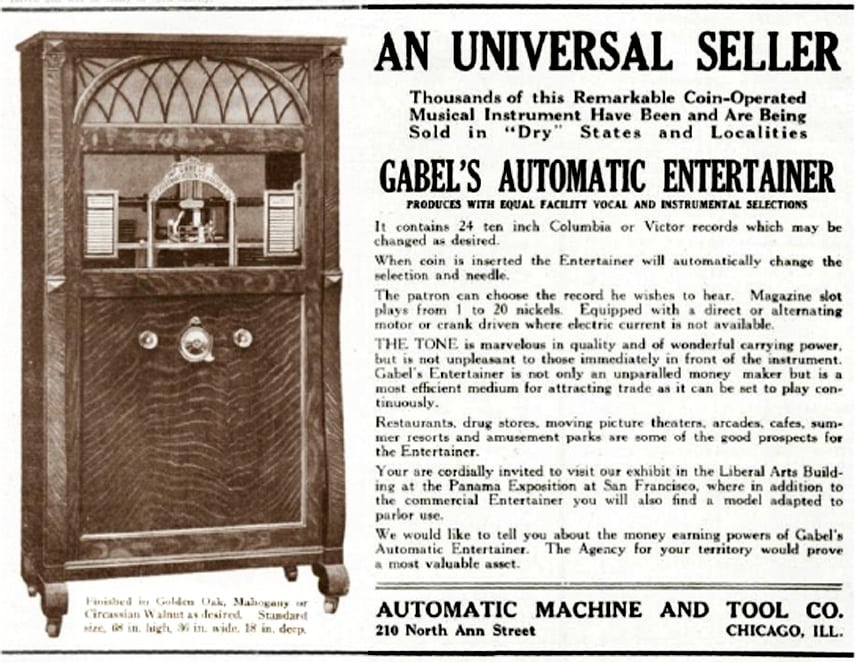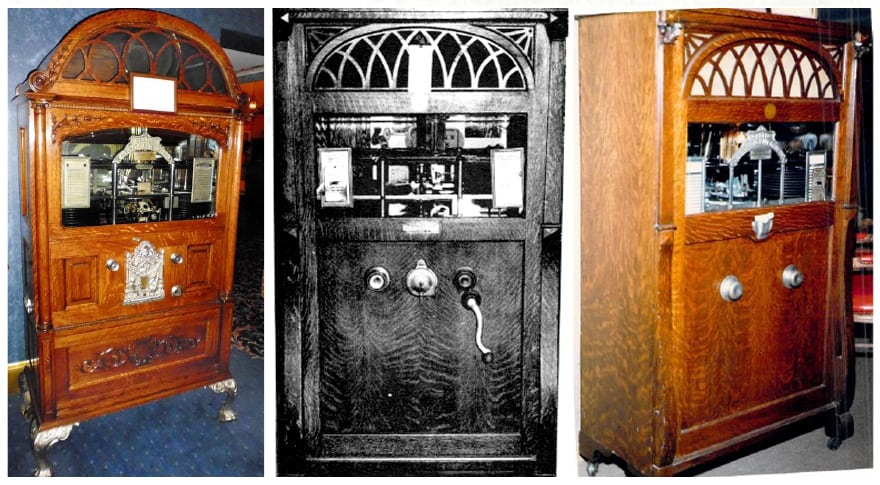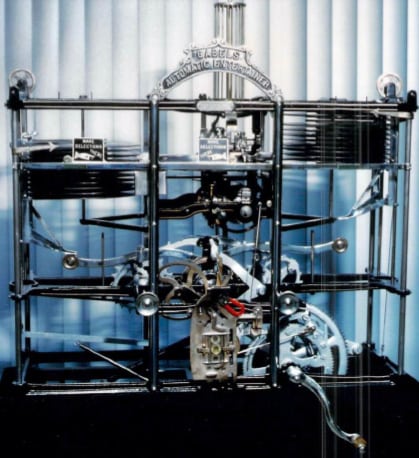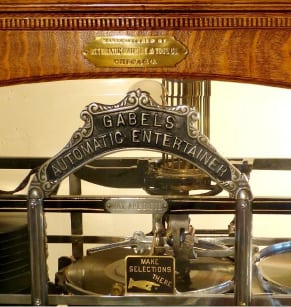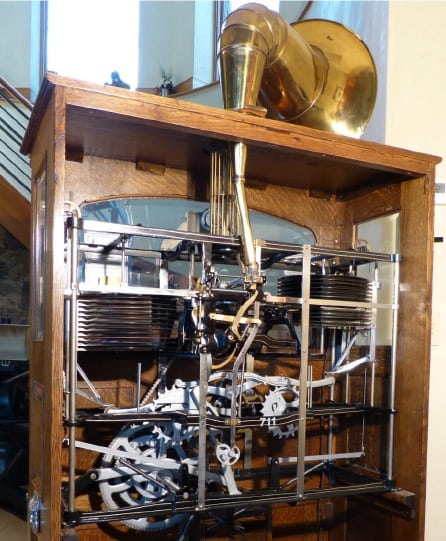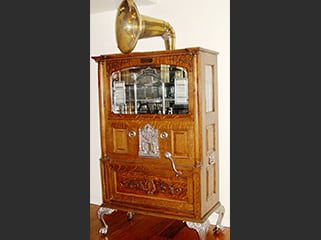
Rick Crandall
September, 1984 and revised April, 2016
Shown here is a legitimate card from the once-popular game of Trivial Pursuit. So how did the designers of the game know about John Gabel? Surely not more than a small number of collectors could answer the question posed. For a while I thought that somehow that card was written for me!

John Gabel was an early inventor associated with the phonograph, but he has been lurking in the shadows. The first coin-operated, cylinder phonograph appeared in 1889, and the first coin-op, disc machine was introduced in 1898. But for those in search of the multi-disc, selector, coin-operated player, Gabel’s contributions were early, important and not well appreciated.
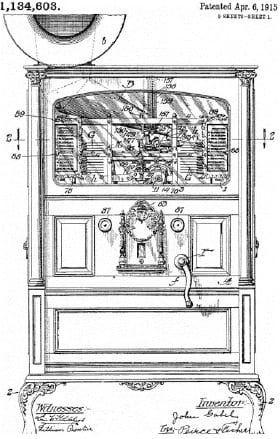
Fig. 1: “automatic acoustic- disc phonograph” patent filed 1906
A study of the U.S. patent files turned up #1,134,603 granted on April 16, 1915, for an automatic, acoustic-disc phonograph with an ingenious device that even changes the steel needle after each record is played! While 1915 was much earlier than the first real jukeboxes (AMI, Mills, Seeburg, 1927-29 era), the patent was actually filed in February of 1906. Now, that is early!
One look at the patent drawings depicts a beautiful machine that would catch anyone’s eye: a fancy wood case with beveled-oak panels, ornate castings rivaling the cases of the early upright gambling machines, windows on all sides and a large brass horn on top. That would certainly satisfy the beauty criteria for most collectors, but the machine’s appeal doesn’t stop there.
A further look into patent drawings of the mechanism and a read through the dry language of the patent show great mechanical ingenuity. Two stacks of twelve individually-selectable 10″ acoustic-disc records, a coin mechanism with an early magnetic slug detector, an advanced tone-arm design, weight and size compensators to adjust for the lack of record standards, and more. Everything including the record changer, needle changer, tune indicator, play counter and turntable was powered automatically by one full turn of a gambling-machine-like crank, all mechanical.
Some of us have known existing examples of a later version of the Gabel Entertainer housed in a somewhat plainer case but still quite attractive, with tone quality that is indeed superb. The mechanism is nearly identical to the patent drawings. These machines usually carry a patent plate with dates like 1909 and 1916, and so collectors have not known how to classify them. It was too early for the jukebox era, but too late to be a progenitor in the phonograph era.
Fig. 2: Early “exposed horn” Gabels Automatic Entertainer Serial # 711, ca. 1907-08
Rick Crandall Collection
The later design incorporated an enclosed horn. It is sought after, and known examples today number less than two dozen as of this writing in 1984, making it a rare and desirable machine.
But who was John Gabel and what about the exposed-horn machine pictured in the patent of 1906? There is a provocative mention of the Gabel in From Tin Foil to Stereo:
“The Automatic Machine and Tool Company of Chicago (Illinois) manufactured the first truly selective disc mechanism. Although spring-motor operated, it was automatic, permitting a choice of 24 selections stored in racks at either side of the turntable. Gabel’s device had a screw-feed mechanism to carry the sound box across the record; it was also equipped with a magnetic-slug detector. The entire operation by the patron was confined to one handle at the front of the cabinet that powered changing the record, the needle, and the turntable all in one crank. In the industry, the John Gabel Automatic Entertainer is recognized as the true progenitor of the modern juke box, yet this was only 1906!”
The progenitor! So why has there not been more coverage of John Gabel and his wondrous machine? A thorough check around the collector community yielded a possible answer. No examples of the 1906 machine were known to exist and no advertising or other literature had yet surfaced to describe the man, the machine or the company.
So who was John Gabel and would we ever see his early machine? Was it ever commercially manufactured?
In 1981 the first breakthrough occurred. A gambling-machine dealer in Chicago was given a lead to check out a “horn phonograph in a slot machine case” located in a factory building south of Chicago. In rapid succession, the machine (serial #711) flew through the hands of a picker, a slot dealer and a collector, with breathtaking price appreciation along the way. Finally, there it stood, in all its unrestored, non-working but complete glory, in my own spare bedroom.
Piece by piece I nervously dismantled the machine. Each sub-assembly and then each screw, gear and spring was photographed. The dismantling procedure was carefully recorded. This machine was a one-of-a-kind for the moment, and I was not going to be the one to have taken it apart beyond reassembly. A year and several stripped-gear restorations, cleanings, buffing, plating, etc., later, it was ready for final regulation.
The result is as pictured in Fig. 2. A magnificent appearance, flawless repetitive operation (as of this revision the Entertainer has played more than 500 records without a single malfunction) and in the words of many: “The best tone heard from any phonograph of comparable age.” Anyone who takes a look inside a Gabel machine will concur that Gabel must have been a mechanical genius.
IDENTITY A MYSTERY
But who was John Gabel? Some information trickled in from slot-machine collectors. There are some floor-model gambling machines that date back to the 1898-1903 period built by the Automatic Machine and Tool Company with John Gabel‘s name on them. Also, a serial number study of the later versions of the Automatic Entertainer indicates an astounding estimate of over 7,000 machines having originally been produced – during a time when no other automatic disc phonograph had been able to establish itself, and when a manufacturing run of 2,000 to 3,000 units was considered highly successful.
The author’s early model received some publicity in 1983 when an article I wrote was printed in Russ Ofria’s Nickel A Tune magazine in a several-part series. It was then that a second example of the horn model surfaced with serial #702. Without close inspection, the only thing that can be said is that the two extant examples appeared to be nearly identical except that #702 has a cast front sign with “The Automatic Entertainer” and the author’s #711 has a similar sign but cast in it is “Gabel’s Automatic Entertainer.”
A third horn model surfaced with an even earlier serial number: 646. Its marquee also omits the Gabel name and uses the lower capacity needle changer shown in the patent drawing in Fig. 1. Otherwise #646 appears identical to #711.
Figs. 3a, b: Horn model #646. This machine is presently owned by the son of a San Francisco music merchant. The son recalls his father handled electric pianos, Wurlitzer Harps, Encore Automatic Banjoes, orchestrions and talking machines.
He said to me: “All of these instruments were in saloons and restaurants. He changed the roll music once a week. During the earthquake and fire a large number of these instruments were lost. In 1926 he sold out his business but he did keep one player piano, one Regina bar top music box and the (Gabel) record player. I have these with me today.”
DIARY DISCOVERED!
The second huge break in the mystery finally came. My friend and noted author on collectables, Richard Bueschel of Mt. Prospect, Illinois, hinted to me one day that there existed a historically-important document on John Gabel. He had gotten nowhere with it, and so almost playfully connected me with a Gabel family descendant to take a shot at getting access to the document. One Saturday morning, after some negotiations, I received a copy of a several-hundred page, typewritten diary of John Gabel’s entire life. Most important were the dozens of pages covering his trials, tribulations and thoughts while inventing the Automatic Entertainer. For the next several days you wouldn’t have been able to contact me – I was buried in that fascinating life’s story. Also included were his perspectives on his competitors and documentation of a colossal, extended legal and competitive battle with the Victor Talking Machine Company, which didn’t even have a competitive product at the time.
For the first time anywhere, I published part of the story of John Gabel and his Automatic Entertainer in Allen Koenigsberg’s Antique Phonograph Monthly, (Vol. VII, No. 8) in the summer of 1984.
There is actually much more to the story which I’ll write at a later date, but there is much here to digest of importance to the history of automatic music.
JOHN GABEL
John Gabel, born in Hungary in 1872, and prevented by early illness from having more than two years of public-school education, became an immigrant to the United States. That was in 1886 when John was 14 years of age and before he could speak a word of English. His father was a nail smith which, in the fashion of the day, set John on a course of metalworking apprenticeship. In the U.S. he continued at odd jobs which helped him produce some income during his stay with his brother in Philadelphia. Two years later, when John was 16, he was encouraged by a friend of the family to try his fortune in the city of opportunity – Chicago.
Fig. 4: John Gabel
In Chicago he found great demand for machinists. Slowly he learned English. It was the age of the gear, the cog, the cam and the lever. Everybody was trying to do everything and anything with mechanics. He wound up with a good job at Felt & Terrants producing and assembling the intricate mechanisms of adding machines, known as Comptometers.
Fig. 5: Gabel’s early training ground – the Comptometer, claimed to “perform every mathematical calculation essential in business.”
Gabel’s skills zoomed, in part from the experience, and in part due to his conviction that he was a “born machinist.“ During the ensuing eight years, he worked for several companies, including early successes producing coin-operated, gambling-machine mechanisms.
Finally, in 1898, the inevitable occurred. John Gabel, with his energetic spirit, inventive mind, metalworking skills, (and no money), became co-founder and president of his own fledgling company. A Chicago cabinet maker put up the funds and the cabinets for Gabel’s own improved version of a floor-model slot machine.
THE GABEL “SLOTS” INTRODUCED
By Christmas of 1898, Gabel’s Automatic Machine and Tool Company, with three employees, had its first all-mechanical, floor-model, gambling machines ready for market. Acceptance was immediate, even though Gabel had no training in selling techniques. By 1900, the Automatic Machine and Tool Company already employed 50 men. Perhaps only in America could a 26-year old uneducated immigrant, self-taught in English, and whose only skill was mechanical inventiveness, start his own company and grow to prosperity in two years!
But we’ll skip over that story for now. We haven’t gotten to the music yet. In 1903, he followed the lead of some other slot-machine producers who sought to establish the legitimacy of the gambling machines through the incorporation of Swiss music boxes that played whenever a nickel was deposited for a chance at a payout. The claim was that the nickel played was to hear the music rather than a gamble at a return (wink wink).
During Christmas of 1903, Gabel went to see Mr. Vosey from the Lyon & Healy Department Store, who was in charge of the brass instruments and Swiss music boxes. After concluding the sale of some music box mechanisms, Vosey drew Gabel‘s attention to the talking machines. Gabel was biased against their “noisiness” and lack of musical quality – undoubtedly a correct judgment of the Victor and others with front-mounted horns and their rigid tone arms. But sometime in the Victor IV or V model time frame (ca. 1903), a newer, tapered-tone arm was designed which made improvements in sound quality.
GABEL STUDIES THE PHONOGRAPH
Gabel took a Victor home, along with Vosey’s selection of ten records, and surprised himself by liking them so much that he played all ten every night for some time. He recalls:
“While I listened to the music, I thought of the possibilities of this new talking machine for public use. At that time there was only one automatic nickel-in-the-slot instrument on the market that made money. It was very crude and the music was awful. It had a wooden roll with iron pegs driven into it. While the roll was rotating, the pegs would contact the keys and operate the piano keys to produce music. The entire system was copied from the Swiss music box, but it was really the only thing on the market.”
We know that the machine he was referring to was the Wurlitzer Tonophone, indeed a crude affair, but it was the first on the market and Wurlitzer actually did well with it.
INSPIRATION STRIKES
Gabel: “It occurred to me that an automatic talking machine would give better music to the public as well as a variety of selections both instrumental and vocal. I made sketches of an instrument of this kind and could not dismiss it from my mind.”
This recollection is a rare opportunity in the research of early machine-age inventions. Here, 100 years later, we can read the thoughts of an important, early inventor, in the first person, at the very moment of conception of the world’s first automatic, multiple-disc phonograph. Gabel envisioned many advantages of this new machine, not the least of which was that, contrary to the gambling machines, it would be legal to operate in all states.
“In the spring of 1905, the first model of my automatic talking machine was ready. It was very crude but worked well enough to demonstrate. I needed money… I had to make a model to be used for patterns and another to send to the patent attorney.”
A Mr. Mikkelson, who had been making the beautiful wooden cases for Gabel’s machines, entered the scene as an investor with $2,000 for a small piece of the company. Another $2,000 came from Mr. Sherwin, the head of Chicago Hardware Foundry Company. The foundry was the supplier of castings to Gabel’s Company.
THE FIRST MODEL . . . AND AN OMEN
In the middle of August, 1905, Gabel took a machine to patent attorneys Pierce, Fisher and Clapp, who were, fatefully, also the patent attorneys for the Victor Talking Machine Company. By the end of October the patterns were ready and Gabel had three music machines made.
“On Christmas Day 1905 we held a party at the company’s office. We played the three machines, and we all began to dance.”
A few days later one of the machinists named the device: The Automatic Entertainer. One was given to Joe Hallner, a Wisconsin dealer in slots. There was no trouble with the mechanical part, but after three days the sound deteriorated. Gabel concluded the only thing wrong was record wear. The original grooves were actually gouged out by the steel needle (a known problem then since the records were actually made of hardened shellac). All three machines developed the same problem.
NEEDLE CHANGER CONCEIVED
Gabel recalls: “To improve the sound was not in my line. I was a mechanic, not a musician. It was necessary for me to think fast. The first thing I did was to look for the cause of the record wear. That was easy. The needles had been made with a fine black diamond point, believing that the point would be permanent. I was mistaken as the continuous grind of the record wore down the fine point of the needle and the dull point wore out the records.
Fig. 6: Close up of the tone arm. A Needle drops from brass tubes (blue arrow) into funnel (red arrow) and then “fingered” (yellow arrow) into position. Used needles are deposited in a tray (green arrow) and rolls down into a catcher bucket.
I wondered what could be used to substitute the diamond point so that the operator would not have to change the needle too often. First I experimented on an adjustable needle, using a steel wire which I fed through a hollow brass needle and fastened it to the end of it. This gave a lot of grief. If I used a wire fine enough to reach the bottom of the record groove, it would cause vibration and the sound would not be clear enough. If the wire was stiff enough to prevent vibration, it would scratch and spoil the records. This convinced me that the record grooves were V-shaped and that it would be necessary to use a needle with a point to fit the V-shaped groove for the record. That is the reason why the Victor Talking Machine gave the best results when played with the Victor needle.
So I decided to make an automatic needle-changing device. Within a week I had solved the problem and made a needle magazine as well as a movement in the machine to operate the magazine so that a fresh needle could be dropped into the sound box for every record.
This was done in time to incorporate the needle changer in the diagram for the first patent application.
The needle-changing mechanism completed my experimental work on the Entertainer. The needle-changing mechanism was used on the Entertainer until 1929 – a period of 23 years.”
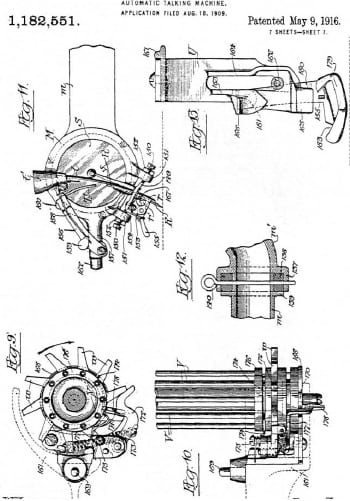
Fig. 7: Patent drawings show the reproducer (Pat. Fig. 11) the needle dispenser (Pat. Figs 9, 10) and the needle catcher (Pat. Fig. 13).
AUDIO SUPERIORITY AND PATENT DISPUTES
Gabel: “When the experimental work on the mechanism was completed, I set my mind on improving the sound. That was my greatest problem. I worked day and night including Sundays . . . until I was satisfied that I had the best sounding machine on the market. This included the Victor Talking Machine which was considered the best talking machine in existence.
In 1915 at the Panama Pacific International Exposition in San Francisco, the Judges decided that my machine was the best sounding machine and it was awarded the first prize (Gold Medal) in competition with all other talking machines including the Victor.”
But even back in 1906 when the Entertainer was put on the market, trouble brewed immediately with the Victor Talking Machine Company.
Gabel’s patent law firm was concerned about the conflict because the law firm was in the middle as Victor was an enormous client. They arranged a meeting at the Victor factory in Camden, New Jersey, to where Gabel had a machine crated and sent.
The meeting was with a Mr. Geisler, the manager of the Victor legal department. Geisler’s reaction to the Entertainer:
“This is a disgrace to our machine. We have a fine, rich-looking machine and we are selling to the finest class of people in the best homes. This thing must be operated in the cheapest type of saloon and will play our records. It will cheapen our machine.“
Gabel surmises: “The president of the Victor Company, Eldridge Johnson, was in Europe, and Geisler may have been interpreting Johnson’s envisioning of the Victor machines as a genuine musical instrument intended for the best homes.”
Upon Gabel’s return to Chicago, Pierce, of the law firm, told him that Victor had a special fund of one million dollars on reserve for interference law suits. “If they do not like a person, they find a way to bring suit. Last year {in 1905) we put a firm in Michigan out of business.”
Then followed an interesting debate between Clapp and Pierce, both of the same law firm. The worry was that Victor was very confident of the patent strength of the Berliner record-groove-driven reproducer that it felt compelled to boast in ads in the Talking Machine World. The ads stressed the importance of its Berliner patent #534,543:
“That the Victor Company controls the disc-reproducing machine and disc record, where the reproducer is vibrated and propelled by the record … the Victor Company hesitates at anything like bragging, but the Victor Company is on top.”
SMALL PATENT DETOUR PLANNED
Clapp confided in Gabel: “I mean we can get around it, John. Is it possible to bring the sound box across the record by means of a screw-feed instead of that free-swing motion controlled by the record groove?”
Clapp felt this would get away from the Berliner patent and Gabel implemented it in one day. The first patent, #1,134,603, filed on February 26, 1906, shows the machine that must have been prototyped and then triplicated in late 1905. It reflects the addition of an early version of the needle changer in that it does not yet show the finger on the reproducer that positively pushes the new needle into place before playing a new record. The patent also does not show the change to the feed-screw propellant for the tone arm.
The machine shown in the patent drawing is, therefore, a pre-production model. Once the feed screw was added, the horn was moved to the center of the case and a spring-loaded, telescopic connection made from the horn to the tone arm.
The Gabel machine is loaded with features, many of which are there to insure the reliability of operation under adverse conditions. For example, the Entertainer automatically adjusts for the small differences in actual record size (owing to a lack of standards in 1905). The mechanism also permits the listener’s selection of the next disc to be played while the current disc is still playing via an ingenious double-clutch arrangement.
Best of all is the unified, automatic operation that powers all functions from one simple turn of the crank. The Gabel Entertainer eliminates the bothersome problems that undoubtedly were the undoing of the contemporaneous cylinder-record changer called the Multiphone.
The horn has a movable baffle: a metal tab that slides in and out of the base of the horn and controls the volume. In the closed position, the listener can comfortably hear the record while standing in front of the horn. With the baffle pulled out, the listener can be across a 30-foot room and catch every word easily.
Fig. 8: Front of mechanism showing coin acceptor with magnet slug-detector and 3-coin window.
The coin slot displays the last three coins played so that the proprietor could tell if patrons were trying to slug the machine with fake nickels. Putting the last three coins on display was a preemptive measure that had already been used in gambling machines. Another feature was the visible coin counter which allowed the proprietor to see that employees weren‘t stealing from the coin box. The second patent (#1,182,331), filed August 18, 1909, contained all of the improvements mentioned, but no additional features. The second patent depicted a mechanism that is identical to the horn model in the author‘s collection, indicating that once the mechanism design stabilized, no improvements were needed over long periods of time.
After the patent application was filed in February, 1906, Gabel brought the machine to market. It was a beauty in its quartered-oak case, richly figured and decorated with beveled panels and opulent nickel-plated castings, and best of all, the large, polished brass horn gleamed on top. This 1905 version of the Automatic Entertainer was an immediate success. During 1906, Gabel, as salesman, made many sales to music houses and to dealers of the Victor Talking Machine Company. The success of the machine did not go unnoticed by Victor.
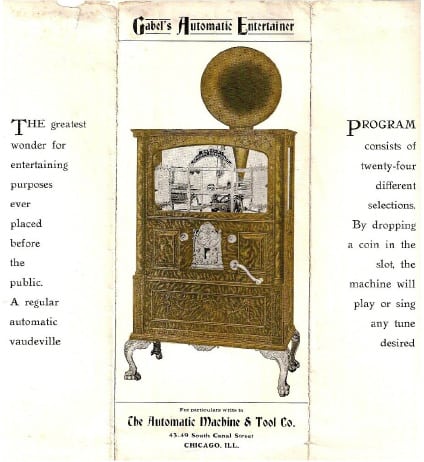
Fig. 9: Gabel’s Entertainer promotional flyer; the beauty of the machine was emphasized by use of color printing.
VICTOR THREATENS SUIT
In January of 1907, Pierce, the lawyer, told Gabel that Victor wanted to file suit. In a rare burst of ethics for that period, he said he decided to defend Gabel:
“John, money is not the only thing in the world. They would buy me as they have bought others. No. John, I value my pride and honor more than the almighty dollar they are slinging at me. If the Victor Company brings suit against you, they will find me fighting on your side.”
Soon afterward, the suit was indeed filed and Pierce did defend. However, Gabel’s business was immediately affected. The dealers of the Victor Company backed off immediately, and some even returned machines that were as yet unsold. Gabel went on the road to protect his business. This is the kind of situation where the phrase “loneliness at the top of the corporate ladder” gets its meaning. To New Orleans, Texas, Arizona, California, Nevada, Utah, Colorado, Nebraska, Iowa and Illinois he travelled. He could not talk Victor dealers into continuing with the Entertainer due to the hold Victor had, so he concentrated on the independents. On the road he found other problems, all endemic to getting acceptance for a new product:
“In Monroe, (Louisiana?) I found the Entertainer was in the hands of a piano dealer who operated electronic pianos. His help did not know a thing about automatic mechanisms, nor did they care to learn. I asked the proprietor to show the machine to me. When I removed the door I pointed to a small spring that had been unhooked from the screw-feed nut. Someone had deliberately unhooked the spring.
Early in March, 1907, a short time after the earthquake, I arrived in San Francisco. Two of the music houses there had my machine, Bacigalupi and Eilers.”
Both Bacigalupi and Eilers were the most important distributors of all kinds of automatic music machines on the West Coast. Eilers was the Eilers Piano House, headquartered in Portland, Oregon, with outlets all over the West Coast. Neither of these houses was controlled by the Victor Company, but Bacigalupi was the father-in-law of Leon Douglass, the retired Vice-President of the Victor Company. Bacigalupi offered to take Gabel out to see Douglass, who had retired to an estate near San Francisco.
A SLIP OF THE TONGUE?
On the visit Gabel met Douglass and his wife Victoria on a leisurely Sunday afternoon. After lunch, Gabel managed to chill the afternoon by putting his foot in his mouth with an innocent statement that was taken to have a double meaning.
“… in the afternoon we walked through the orange and lemon grove. It was the first time in my life that I ever picked a lemon from a tree and I remarked that it was the first lemon that I had picked since my marriage.
I don’t know why I made that remark. I had no reason for it as my married life had been very happy. I suppose the remark was made to be funny.
Mr. Bacigalupi was standing beside me and kicked me in the shin. Mrs. Douglass turned and walked away. Then Bacigalupi told me that my remark was out of place. He told me his daughter and Douglass were not very happy together. I regretted the remark, not only for the sake of the Douglasses, but for Bacigalupi, who had been so kind to me. We soon left, but the parting was somewhat cold.”
Upon returning to the hotel, Gabel learned that Bacigalupi had paid $15,000 for one of the large Wurlitzer “organs.” It was a coin-operated machine in the hotel dining room (probably a large Pianorchestra that Wurlitzer imported from Phillips in Germany) and it was out of order. He said a mechanic had been working on it for two days and was beginning to take some verbal abuse from the two Bacigalupi sons. When the service man was alone, Gabel walked over and offered to help:
“Bacigalupi had wired Wurlitzer to send a mechanic to San Francisco to fix that organ and this Italian was the mechanic. I had never seen the inside of one of those instruments. However I studied the mechanism and he tried to explain how it should work.
I asked him to give me a couple of slugs and he left me alone. I placed a slug in the slot, watched the mechanism and called the man, Pointing to a pawl, I told him to take it out I examined it and showed him where and how to file off the end. After replacing it, he put a slug in the slot and the instrument started to produce music.
The Italian was so happy that he shook hands with me and thanked me while the tears ran down his face. The two sons came rushing in and wanted to know how he fixed it. They were so pleased that they invited me to lunch with them. From that time they were my friends and promised to keep my machine as well as buy more.”
Gabel was ready to leave San Francisco, but had run out of money. The city was in ruins from the earthquake (Gabel was still feeling the earth tremors during the visit) and the only transportation was the horse and wagon. All classes of working men were on strike so it was expensive for him to move around.
With his typical, simple resourcefulness Gabel recalls:
“I dared not tell Bacigalupi that I was broke. Fortunately, I met Tom Watling (of gambling machine fame) and borrowed five dollars until I could get some money from Chicago. I still had some stops to make, so I stopped in the saloons of every town that I visited and repaired slot machines to pay my expenses.
In Salt Lake City I sold ten Entertainers to Carstensen and Anson. I had to stay there two days longer to land that order. Although I was broke, I could not tell Carstensen and Anson that the President of The Automatic Machine & Tool Company was unable to pay his hotel bill. That evening I scouted around in search of a broken slot machine that needed repairing. I found one and it was tough. It took two hours to repair the machine and when I charged five dollars for the work, he (the proprietor) threatened to throw me out. When he called me a robber, I told him that the machine would take in five dollars that night. He said: ‘All right, I will pay you the five dollars when the machine earns it!’
I was very tired and it was after ten o’clock, but I had to wait until after two o’clock for my pay and my train was leaving for Chicago at eight o’clock. Thanks to the old slot machine, it took in five dollars in four hours.”
EVERY PART NECESSARY
In order to show how important it was to have a good man on the road in the amusement-machine business, Gabel recalls a few more stories from that whirlwind trip:
“At a music store in Sacramento there were two Entertainers. I was informed that the machines were continuously out of order. I looked at the machine and asked what had become of the needle magazine. The mechanic said: ‘That is what gives us so much trouble.’ He brought the needle magazines to me and, as soon as I touched them I asked how the oil got on them. He told me the needles were stuck in the tubes and so he oiled them. I assured him that the needles would not stick in the tubes if the tubes were filled properly. I showed him that the needle was too light to slide through the tube with oil in it.
I gave the magazines a gasoline bath and during reassembly I asked for the needle gauge. He did not know what I wanted. I showed him where the round steel plate with a small hole in it should be placed at the top of the needle magazine to keep the dust out of the tubes and to prevent the needles from falling out.”
“The man said: `I do not use that thing.’ I told him he would not have trouble if he had filled the needle magazine through that needle gauge. I picked up a needle on which there was a burr. I tried to put it through the gauge and it would not go through. Then I removed the plate and put the needle into one of the tubes. It stuck in the middle of the tube. In this way I showed him the importance of the gauge to prevent the clogging of the mechanism.
I explained that our factory would not put a part on the machine unless it was needed and that this needle gauge was necessary.”
That is a lesson that many a modern-day restorer could well learn about all kinds of automatic-music machines with mysterious and seemingly unimportant features. These machines should be put back to original condition – it generally proves out the designers knew what they were doing.
RECESSION OF 1907
The year 1907 was notable for its national economic crisis which added to the stiff competitive methods of the Victor Talking Machine Company. Lyon & Healy bought an Entertainer and actually shipped it to Victor to ask permission to sell it. Victor responded with an emphatic “NO,” and the sample machine was returned to Gabel with the message: “The Victor Company will not permit us to handle it.“ Such was the power of Victor.
J.P. Seeburg himself had purchased an Entertainer which was promptly delivered to his Chicago loop office for display in his main showroom. However, Seeburg judged it as a competitive threat to the automatic-piano business (how prophetic) which was just getting up a head of steam, so nothing was done with it.
Gabel recalls: “While the Victor caused a lot of grief, the piano manufacturers, dealers and operators were also a menace. The electric piano was on the market before my Entertainer and the country was flooded with them. It was natural for those who had invested heavily in pianos to be interested in keeping the Entertainer out of the way.”
Then it seemed the big break came in August of 1907, when Howard Wurlitzer himself came to see John Gabel. Wurlitzer was, without question, the marketing powerhouse in the country and Wurlitzer was very favorably impressed with the Automatic Entertainer. He made Gabel a proposition that would make Wurlitzer the exclusive distributor of the machine. Given business conditions, the offer was like “an angel from heaven.“ However, John Gabel was becoming more of a realist and he asked Wurlitzer how he would get permission from the Victor Company to handle the Entertainer. He recalled Wurlitzer saying that the Victor Company had nothing to do with Wurlitzer and that Wurlitzer made and sold anything they wished. In his typical brash style, Howard Wurlitzer said:
“…if the Victor Co. does not like it, let them come to us and I will talk to them as I would to my Dutch uncle.”
To prove his good intentions, even before a deal was consummated, Wurlitzer ordered 100 Entertainers that same day. During the ensuing 30 days, Gabel made all the machines he could, a total of 26. These were still the early horn models which were all shipped to Cincinnati, Ohio.
VICTOR PRESSURES WURLITZER
Soon after, Wurlitzer returned to Chicago saying that he had been called to Camden, New Jersey, and Geislcr put the arm on him. Wurlitzer had a jobber’s contract with the Victor Company for the cities of Cincinnati and Chicago and if Victor cancelled their contract, Wurlitzer would be stuck with S700,000 in goods that apparently could not be resold through normal distribution without a contract.
So it was back to the hard-selling life for Gabel, compounded by a forced move of the factory from 43 South Canal. The Northwestern Depot was scheduled to be built where the Automatic Machine and Tool Company was located, so the factory was moved to 210 Ann Street. While all this was going on, the Victor lawsuit day of reckoning was approaching and Gabel was spending an increasing amount of time being drilled by his attorneys in preparation.
GABEL VS. VICTOR
“This case meant a lot to me. A decision in my favor would mean new life to me and the business and it would mean bankruptcy should the decision be against me. On the last day, Mr. Clapp instructed to send one of my machines to the court room and to set it up so that I would be sure it worked. I followed his instructions.
The Victor Company’s man set up one of their machines in the court room so that the stage was all set for the hearing in the afternoon. Judge Kohlsaat presided. The attorney for Victor, Mr. Pettit addressed the court and explained the broad claims of the Berliner patent. Then he demonstrated on his exhibit the claims that were involved in the infringement suit. The judge had a paper before him. No doubt it was a copy of the Berliner patent.
Mr. Clapp addressed the Court. In his calm slow manner, he started to talk. Finally, Judge Kohlsaat told him that it was not necessary to pace back and forth nor to talk further about the Berliner patent as he knew it by heart.
Mr. Clapp begged the Court to permit him to demonstrate the movement on his opponent‘s machine. He said `Your Honor, the broad claim of the Berliner patent is a swinging arm with a reproducer on the end. The stylus of the reproducer sets into the groove of the record and the grooves of the record then carry the reproducer and arm across the records. The Gabel machine has no swinging arm. Neither does the groove of the record feed the reproducer across it. I will demonstrate this fact by playing the Gabel machine.’
He said: `Your Honor, the reproducer and arm on this machine are carried across the record by a screw feed. I will now disconnect the screw feed. Please watch the results.’ As soon as he disconnected the screw feed, the reproducer continued to repeat the same sound.
He said: `Now, Your Honor, you can see that we are not infringing on the Berliner patent.’ Judge Kohlsaat gave his decision then and there by saying that he could see no similarity in the two machines, so there could be no infringement and the case was dismissed. The Victor Company had lost the case and it gave me new life. With a free mind I was able to think of improving the business and to increase production although the Victor Company continued to spread trouble for me all over the country with their antagonistic attitude and false statements.”
VICTORY IS SWEET- A REFINED MODEL INTRODUCED
The year 1908 began on a better note. Sales were increasing and Gabel began assembling a network of state agents. Joe Hallner from Wisconsin began buying machines for resale and by 1909 Mr. C.L. Fox bought several machines for St. Louis, Missouri, and the surrounding areas.
In 1909, Gabel made some changes to the Entertainer. While the mechanism stayed the same (it had proven to be very reliable), he added an electric motor to replace the crank. He also replaced the external horn with an enclosed horn covered by grillwork in a taller case to accommodate the horn. The fancy castings were eliminated and the overall appearance was directed more toward a less showy, more refined device.
Fig. 10: Left – fancy enclosed-horn model electric or crank operation (Jasper SanFilippo collection); Middle – crank-only model; Right – later model with crank replaced by an electric motor, otherwise all mechanisms are very similar.
Collectors today prize the horn models of most phonograph types, but back in the 1910 era the horn was considered a necessary evil, and awkward as well. The Entertainer with an enclosed horn was considered an improvement in appearance then. The front, beveled-glass window was retained so that the mechanical intricacies of the machine were still in view. The 1909 version achieved great success with the Victor lawsuit settled and an improving network of dealers was gradually established.
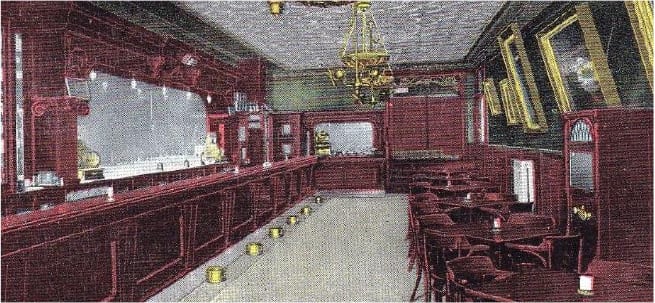
Fig. 11: Gabel’s Entertainer (near right) on location at Louis van Dall Café, 63 Michigan Ave., Detroit
ANOTHER PATENT INTERFERENCE
A brief cloud came on the horizon in 1910 when a well-known and successful distributor of music machines in Philadelphia, Pennsylvania, Julius Wellner, informed Gabel that he was interfering with Wellner’s invention.
“That was news to me as I had never heard about it before. I asked Mr. Wellner to accompany me to our attorney’s office, which he did. Wellner was truthful enough. He told us that his machine would not work, and that the purpose of his visit to Chicago was to make arrangements to be a distributor for my machine, and that a $10.00 commission on each machine should be applied as royalty.”
The attorneys talked Gabel into the idea that the royalty was low enough to be a better proposition than an expensive legal fight. So the deal was accepted and Wellner bought “a substantial number of machines and we parted on a friendly terms.”
As it turned out, the run-in with Wellner was fortuitous since Gabel was in need of top-notch retailers and Wellner was in the thick of the action on the East Coast.
Gabel’s first patent had been filed in February, 1906, and was still not issued in 1910. As to why the patent application took so long Gabel recalled:
“I had confidence in my attorneys; they had proven themselves honorable when they fought my case with the Victor Co. when I did not have the money to pay them. Mr. Clapp purposely held up the patent papers. His purpose was to get all of the interferences out of the way so that a clear patent with all 106 claims would be granted.”
Resolving the Wellner situation certainly was part of the plan. In 1911 Fox moved his headquarters from St. Louis to Kansas City, Missouri and he was doing good business there. Wellner was doing well in the East; Gabel continued selling machines personally through Indiana and Wisconsin as well as in his home state of Illinois.
In 1912 the Victor Company brought another suit against Gabel. Gabel was on the stand for 17 days and answered 851 questions. His stamina was once again rewarded. In early 1913, he learned that he had won the case and, accordingly, 23 more claims were allowed in the patent – for a total of 129 claims.
Shortly thereafter, the Victor Company appealed the case all the way to the Supreme Court. After a costly preparation process, Gabel and his attorneys showed up in Washington, DC, on the appointed day in the summer of 1913 only to find that Victor abandoned the lawsuit that morning. They were playing an interference and cost-escalation game, but their bluff had finally been called. That marked the end of Victor’s legal attacks.
In 1913, Mr. E.S. Garrett, who managed the Columbia Phonograph Store in St. Louis, Missouri, was so impressed with the Entertainer that he set up an agency in California which succeeded as the Golden Gate Music Company of San Francisco. Hundreds of machines were sold there.
FURTHER EFFORTS TO IMPROVE TONE
“For years we had been buying sheet mica (for the tone arm diaphragms) here in the U S. We would then peel it down to size and select the clear sheets to punch out our diaphragms. If the mica was not clear the sound was cracked. If it was too thin it squeaked and if it was too thick the sound was dull.
When I began using German mica, the sound was greatly improved. But during the summer of 1914 Germany declared war on France and England and the mica diaphragms were no longer available. I decided to experiment with metal. Steel was too stiff and brass or copper would not do. Then I tried aluminum and developed a good sounding diaphragm that was far superior to mica.”
In July of 1915 Gabel received a surprise telegram from Garrett in which he related the excellent news that the Entertainer had received first prize for phonographs at the Panama-Pacific Exposition in San Francisco. Before the end of the same day, a representative of Talking Machine World magazine called and said: “Mr. Gabel, have you heard the news in San Francisco?” Gabel thought he was referring to the good news and showed the telegram. The reporter said “Oh that is wrong. I have received a telegram from San Francisco stating that Marshall Field & Company was awarded first prize. I have a story here from Marshall Field & Company for Talking Machine World”
GOLD MEDAL CONFUSION
It would appear that Gabel didn‘t quite have the full story about Marshall Field. An all-day perusal of the Talking Machine World of 1915 by Allen Koenigsberg produced a mention in the April 15, 1915, issue that the Cheney booth was designed by Marshall Field & Co., and other hints about a forthcoming, unusual machine which apparently never did appear. Gabel perhaps did not know that Field’s was only a distributor for Cheney. He goes on to recall that the Field story had to be retracted and that the Exposition Commissioners closed the Fields/Cheney exhibit for making false statements. Allen Koenigsberg could find no such printed retraction, although he did find a September 15, 1915, Talking Machine World mention of the Gabel win:
“… the Entertainer was awarded the gold medal for automatic talking machines by the exposition authorities. This includes an award ribbon and large banner. Substantial shipments of Gabel‘s Entertainer have been made recently to Hawaii, the Philippine Islands and Australia.“
The Gabel exhibit was in the Palace of Liberal Arts. Upon entering the Palace, he found Garrett in his booth in the midst of emptiness. All the other major phonograph companies (Victor, Columbia and possibly Cheney) had cleared out, Garrett said: “Oh, Mr. Gabel, you should have been here to see the fuss that those fellows made and how angry they were.“
The Victor Company appealed to the Commissioners and accused them of unfairness.
Gabel recalls: “They had placed over a dozen machines throughout the grounds, free of charge, as an ad. Their action (the appeal) did not appeal to the public favor. The people were talking about them and said that they were selfish and conceited and sore because they did not get the first prize.
Mr. Charles Moore, President of the Panama-Pacific International Exposition congratulated me on my fine exhibit and wonderful invention. Then he presented me with the Gold Medal which was the highest award for any product in the Exposition. There was always a crowd at our booth. The people were fascinated by the nickel-plated mechanism which was constantly in motion, changing records and needles automatically. There was an extra needle magazine which was kept filled – ready to use when the other was empty.”
Gabel had learned some principles of marketing. He tells us that he had one additional special version at the Exposition which was the one referred to above that drew all the crowds:
“Before the fair, I had one mechanism nickel-plated and when it was assembled we enclosed it in a glass case. It was in operation continuously at the booth.”
Can you imagine a Gabel mechanism all nickel-plated and in a glass dome? For anyone who has seen the mechanism, it would not appear difficult to imagine the captivating power it would have.
OFFICIAL EXPOSITION RECOGNITION
Moore had indicated that Gabel would get a full page in the Official History and he kept his word. Here are some excerpts:
“The International Jury of Awards gave Gabel’s Automatic Entertainer a Gold Medal, and the Award was made because of superiority of tone-reproducing qualities of this machine as well as its many other excellent points.
“The jury took into account that the Automatic Entertainer possessed many novel and useful features. It was thoroughly appreciated that in the field of mechanical entertaining, GabeI’s machine occupied a position which would commend itself to those who desired to use it as a coin-operating machine, and also to those who wished to have a practical as well as ornamental sound reproducing device. It would give to the owner no trouble, as its construction was such as to make it fool proof. It obviated the necessity of having an expert mechanic to attend to its needs.”
There were two styles shown at the Panama-Pacific Exposition, one being the instrument used for commercial purposes. This instrument was so constructed as to play from one to twenty nickels at a time, while the other was the home machine, which was operated by the mere pressing of a button.
“Both of the machines held twenty-four standard records, which were so arranged as to permit the playing of any selection preferred, or if the music lover desired, the Entertainer would play continuously, the machine changing records and needles automatically thus giving a lengthy concert.
The motor, which used either a direct or alternating current, was used to wind the machine, and for places where current was not available, a handle was provided so that the machine could be prepared for its work with one turn of the crank.
The trouble with the majority of sound-reproducing devices has been the constant care and attention which must be given to them, and this has been done away with in the Gabel machine.
Another point in its favor is its handsome exterior, possessing a rich and dignified appearance, and from an ornamental standpoint, the machine was so constructed as to grace drawing room or salon.
The fact that numerous machines were ordered by Commissioners and visitors from foreign lands where high-class music is appreciated is another evidence of the worth of the Gabel Automatic Entertainer.
Mechanical experts were very much interested in the machine and were loud in their praise of its construction from a mechanical viewpoint. They were unanimous in declaring that Mr. Gabel has given to the world a device mechanically correct in every detail.”
Orders started pouring in from all over California and the world. John Gabel had finally made an indelible impression for the fine mechanic and inventor he was. While this was 1915, ten long years after he built his first three Entertainers, it still would be ten more years before anyone else would catch up with an automatic selector disc mechanism.
AN AVALANCHE OF ORDERS
The year 1915 was pivotal and 1916 opened with a bang. Orders were coming in so fast that it was impossible to fill them promptly. Gabel still employed 50 men, but his distributors informed him that they needed quantities such as 500 for Minneapolis/St. Paul, Minnesota, 500 for southern California, and so on.
The cases were still made by outside vendors and the mechanism was nearly identical to the first 1905 machine except for the enclosed horn, the motor and double-capacity needle changer. We learned from the Wurlitzer contract of 1907 that capacity was perhaps 30-35 per month, or 350 to 400 per year with 50 employees. Still, it is remarkable how few survive. Perhaps the policy of the jukebox industry to destroy older models contributed to this situation.
Capacity was apparently eventually expanded and the agent network grew. In 1918 Gabel changed the name of the company from the Automatic Machine and Tool Company to the John Gabel Manufacturing Company because he wanted credit for all the lean years and after the protracted fight with Victor.
Gabel went on producing the acoustic Entertainer until 1928, an incredible 23-year life span. In 1928-29 a number of competitors came on the market with electrically-amplified machines that used more permanent needles. These devices avoided the need for a needle changer and were free to compete.
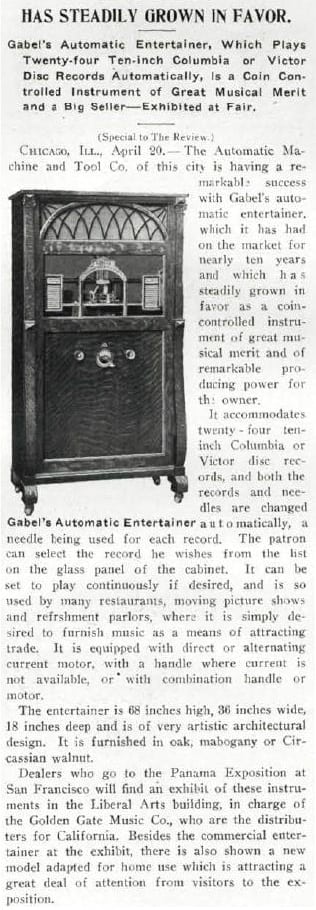
Fig. 12: Article from Music Trades Review
The first Capehart phonograph was still acoustic and ran awry of the Gabel patents. The Capehart Automatic Phonograph Company filed suit against Gabel in September of 1929, attacking the validity of the patents. In January of 1930, Charles Bartholomew of Chicago also filed suit to do battle over the patents. These suits dragged on until 1935 when the Gabel patents exhausted their 17-year legal life. All suits were dropped in October of 1935 and the field reopened for reasons of both patent expiration and technological advance.
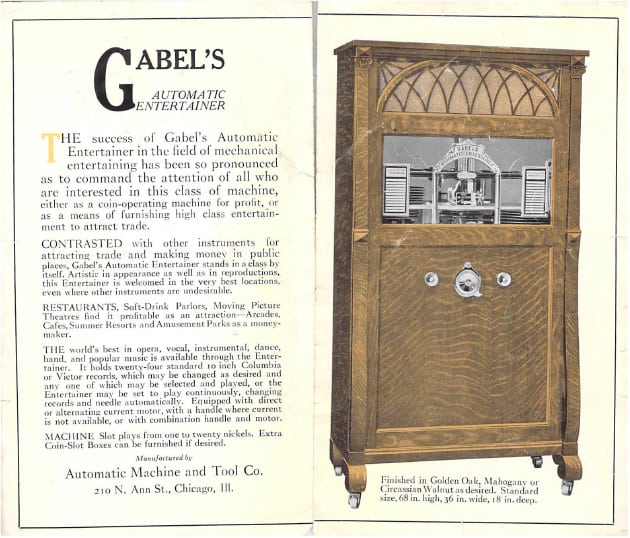
Fig. 13: Gabel’s Entertainer flyer for the electric model. Note mention of another enhancement – a coin accumulator for one to 20 nickels.
JOHN GABEL 1872 – 1955
John Gabel went on to design and produce his own electrically-amplified jukeboxes in oak cabinets. He continued doing so until 1936 when he retired at age 65. The John Gabel Manufacturing Company continued in the jukebox business, joining the plastics revolution, until 1949 when it dissolved and reportedly sold some assets and patents to the Rockola Company.
John Gabel died in December, 1955 at the age of 83. His obituaries in the local papers in Chicago made some reference to his major accomplishments:
“John Gabel, 83, of 253 Linden, Glencoe, who manufactured the world’s first disc-record coin operated jukebox, died Friday…”
Mr. Gabel in 1898 founded the Automatic Machine and ‘Fool Co. which later became the John Gabel Manufacturing Co., at Racine and Lake.
COLLECTOR NOTES
A study of serial numbers and patent labels on extant Gabel machines has been actively underway by Russ Ofria (publisher of Nickel A Tune magazine), Fred Roth (collector, restorer and Gabel enthusiast) and me. Here‘s what we have so far:
1905 – 1909 EXPOSED HORN “PATENT” MODEL
We know that serial numbers of existing machines are in the 600‘s and 700‘s, and there is an enclosed horn machine with serial #815. It is reasonable to guess that 300 horn models were made from serial #500 to serial #800. Earlier versions have “Gabel’s” omitted from the name cast into the marquee. The early needle changer was of lesser capacity, comparable to the patent drawings.
1909 – 1920 ENCLOSED HORN “1909” MODEL
The earliest enclosed-horn models is serial #815, and serial numbers extend well into the 3,000’s, perhaps even the 4,000’s, before a 1922 patent date begins to appear on the patent tag. A guess is that 3,000 machines of this type were originally made. The cabinet is 68” high to accommodate the interior horn (behind the grillwork). The coin entry is a slot in a round, knob-like casting between and level with the selector knobs, and it usually had a motor that took the place of a human in winding the mechanism. The benefit of this simplistic method of motorization was that an optional hand crank could still be offered for areas of non-standard or non-existent power. Otherwise, the mechanism is nearly identical to the exterior-horn model.
Fig. 14: pre-electric Entertainer mechanism, front view outside of case. Rick Crandall collection.
Fig. 15: Gabel’s “signage”
Fig. 16: Pre-electric mechanism from the rear. Rick Crandall collection.
1920 – 1928 THE ENCLOSED HORN
“ELECTRIC-DRIVE” MODEL
Around 1920, Gabel departed from a spring-powered machine and installed a motor-driven belt that powered both the changer and the turntable directly. This model was in a slightly smaller case with a smaller front window, and it sported a light behind the marquee to illuminate the mechanism. The coin-entry casting was changed to a wing shape and was mounted higher than the selector knobs. Otherwise, they were still mechanically similar to the original Gabel machines.
FROM 1928 TO THE EARLY 1940’s
In 1928 or so, the electric jukebox industry was getting a start and competitors flooded in. Case styles varied greatly and electric amplification replaced acoustic as the new technology. Gabel followed suit with several “modern“ case styles and electrical amplification. Still, the basic mechanism was recognizable even on machines whose serial numbers break the 11,000 mark and extend at least to the late 1930’s.
Russ Ofria claims that over half the earlier acoustic machines found have been converted to later mechanisms, in many instances also resulting in the case being cropped down in site because the two-foot long, main-drive spring was no longer needed.
The recycling of older mechanisms would help to explain why the acoustic Gabels are relatively rare.
SUMMARY OF ACOUSTIC GABEL ENTERTAINERS
Model Years of ProductionEst. Original Quantity Approx. No. Known Today
By 1935, John Gabel was no longer spending much time with the business and other competitors took the lead with newer technologies. By 1940, Gabel machines were being regularly traded out by Wurlitzer and others.
The rarity of advertising and other promotional material from his early sales efforts has contributed to John Gabel’s near obscurity. The discovery of his early machine and his diary (with his secretary’s comments), and the subsequent disclosure of this new information in articles such as this should serve to complement the record of early endeavors in the field of automatic music. John Gabel’s contributions will now be a legitimate and remembered part of the history of automatic-music machines.



